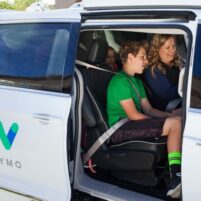Self-driving taxis gain approval in California
November 30, 2020

The California Public Utilities Commission (PUC) has approved two new programs that will allow companies operating autonomous vehicles to run driverless ride-hailing services. [The Verge]
Driverless ride-hailing services, also referred to as robotaxis, presently exist in a couple jurisdictions in the United States. Though California is a leader in the rollout of autonomous vehicles, the state has never previously allowed companies to use self-driving cars to operate commercial ride-hailing services.
Waymo, the self-driving division of Alphabet, the parent company of Google, operates Waymo One outside Phoenix, which provides about 1,000 to 2,000 rides a week. Three other companies, Lyft, Aptiv and Motional, have completed about 100,000 trips in Las Vegas over the last several years. Those operations aside, most autonomous vehicles on the road in the United States are either operating in testing-only capacity or are performing deliveries.
Currently, 60 companies have an active permit for testing autonomous vehicles with a safety driver in California. Five companies — Cruise, Waymo, Nuro, Zoox and AutoX — have an additional permit allowing them to test self-driving cars on public roads without human safety drivers behind the wheel.
The PUC’s new initiatives, dubbed the Drivered Autonomous Vehicle Deployment Program and the Driverless Autonomous Vehicle Deployment Program, will allow participants to offer passenger service, shared rides and to accept monetary compensation for riding in autonomous vehicles, the commission said in a statement.
Commissioner Genevieve Shiroma said the new programs enables the state to study how autonomous vehicle fleets can be leveraged to support the grid, while incorporating transportation into the electric sector. The state plans to ban the sale of new combustion-engine vehicles beginning in 2035.
The companies that participate in the new programs will need to obtain either a charter-party carrier Class P permit or a Class A charter-party certificate in the PUC’s Drivered AV Passenger Service pilot program, as well as an AV testing permit from the Department of Motor Vehicles. The application process is expected to take at least several months.
Additionally, companies that launch robotaxi services in California will have to submit quarterly reports disclosing information about pick-up and drop-off locations for individual trips, availability of wheelchair-accessible rides, service levels to disadvantaged communities, full type used by the vehicles, electric charging, vehicle and passenger miles traveled and engagement with advocates for disadvantaged communities.
California is considered to have some of the most stringent rules for autonomous vehicle operators, which include requiring companies to obtain licenses for different types of testing and disclosing vehicle crashes and the frequency at which human drivers needed to take over control of cars.






The comments below represent the opinion of the writer and do not represent the views or policies of CalCoastNews.com. Please address the Policies, events and arguments, not the person. Constructive debate is good; mockery, taunting, and name calling is not. Comment Guidelines